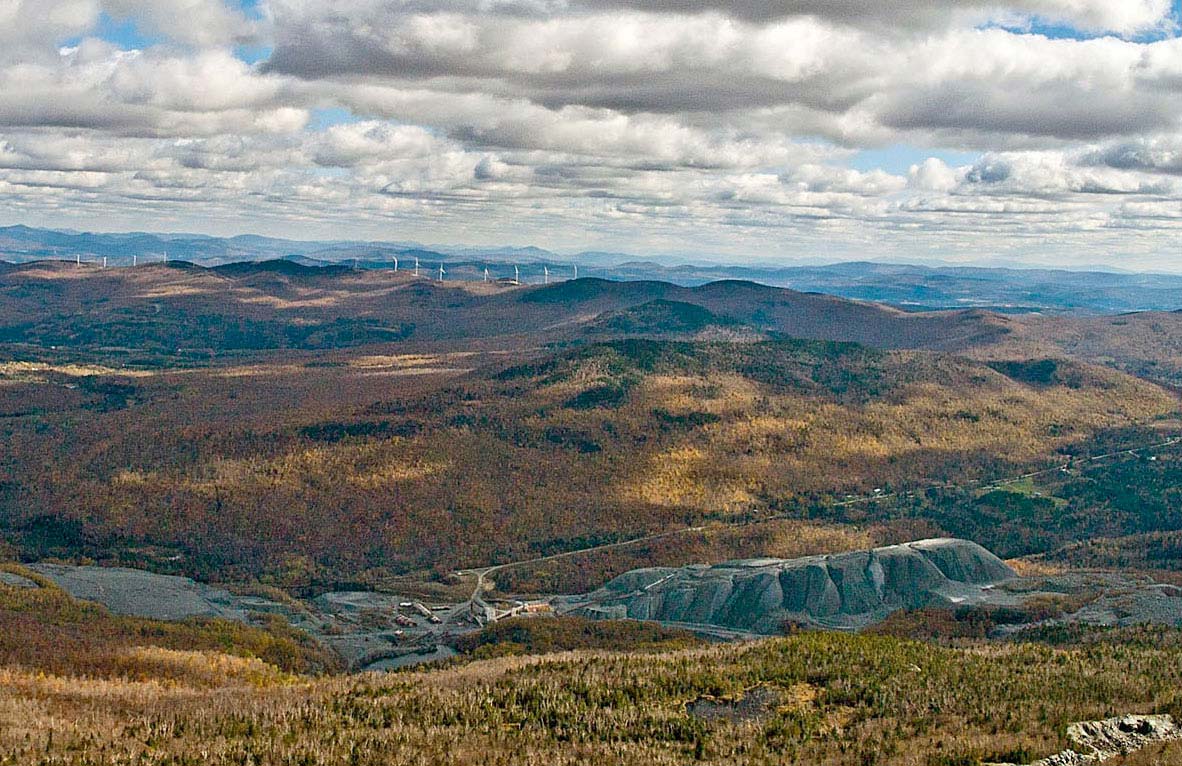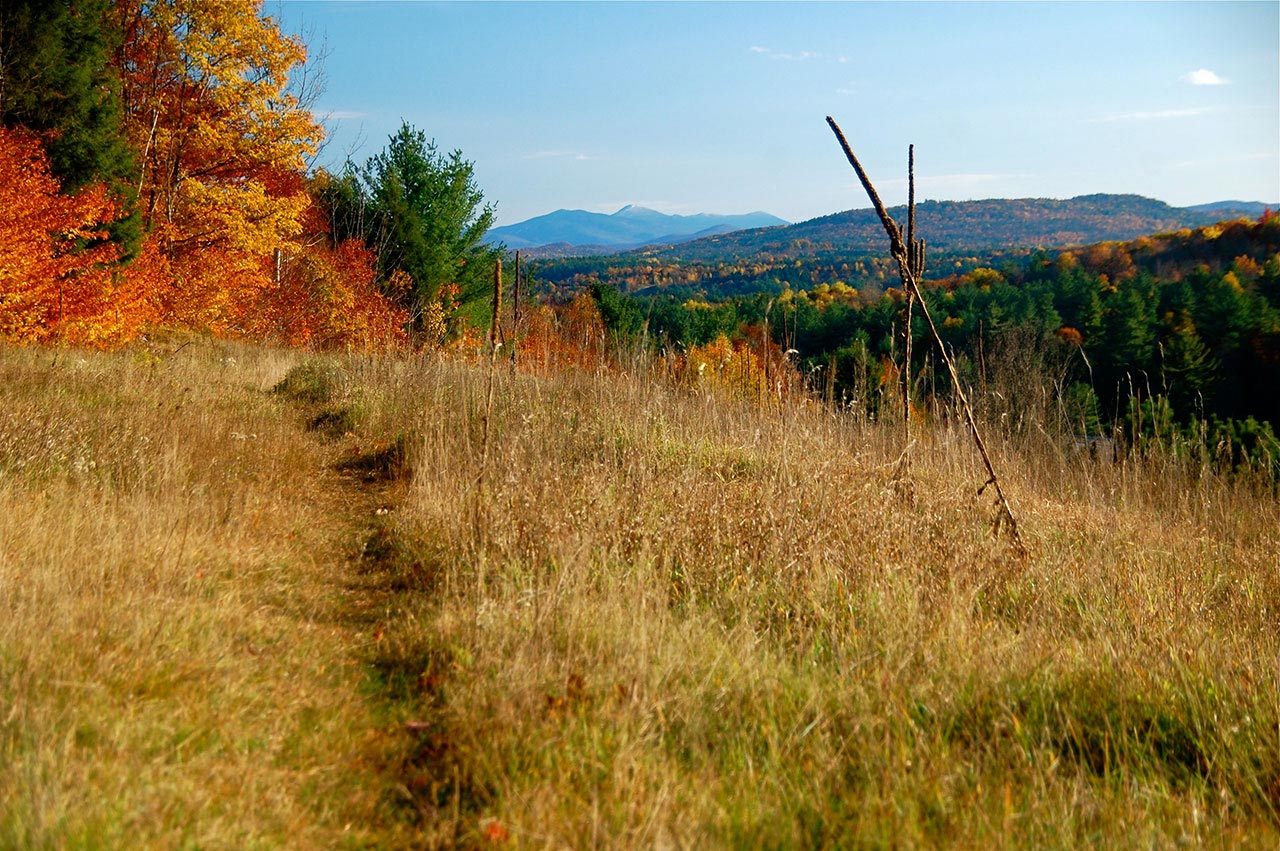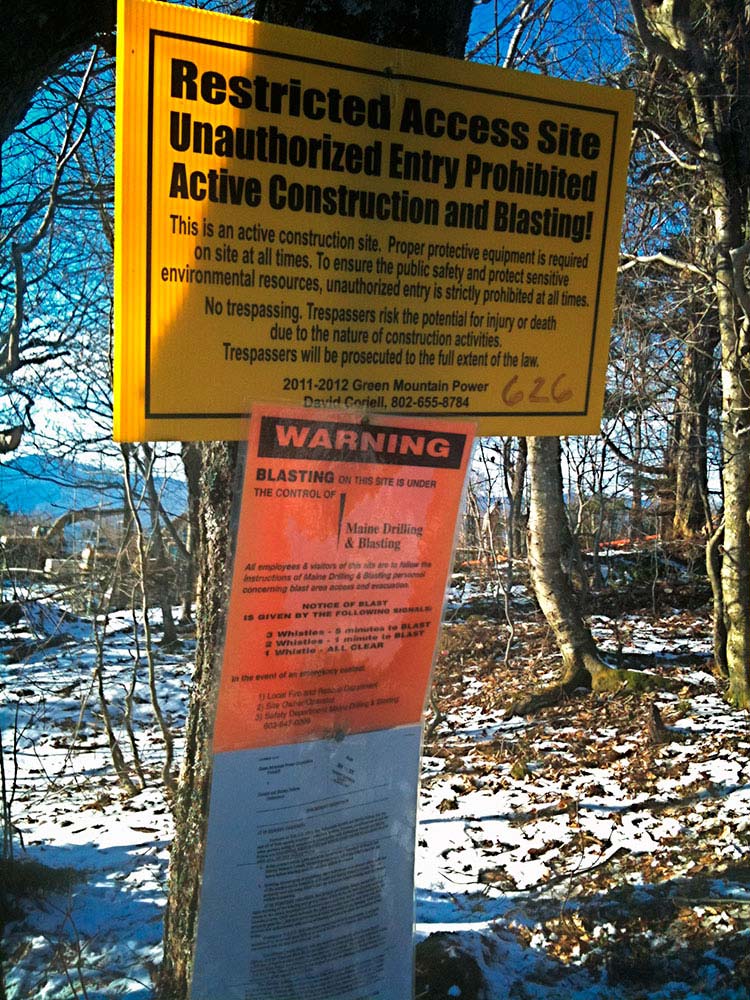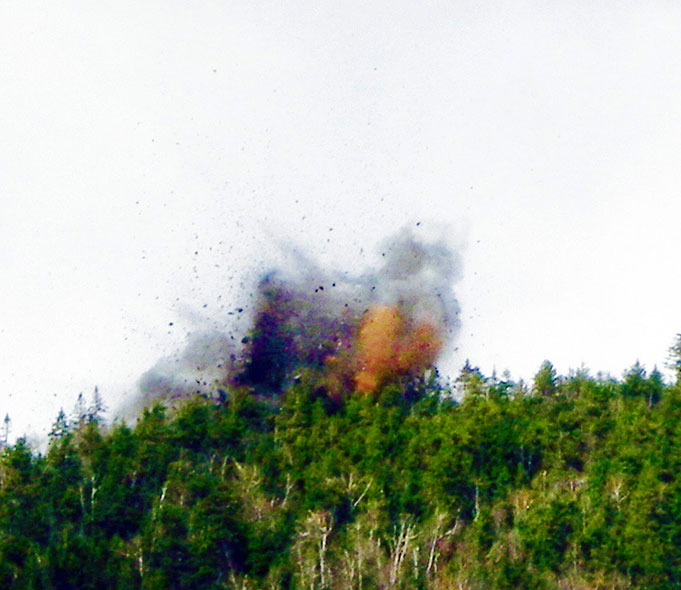
Perhaps the most damaged landscape in Vermont. Operating from the early 1900’s up to the early 1990s, the Belvedere Mountain asbestos mine left a legacy of waste rock and mine tailings. The land had little chance to rest. In 2011, across the valley, Green Mountain Power began blasting Lowell Mountain, bulldozing its way up the mountain to erect the euphemistically named Kingdom Community Wind. Photo: Chad Wohlers
The Mountain Manifesto
“As is well known, Vermont is decidedly a mountainous state. There is, to be sure, abundance of level ground and good tillable land, but dominating all are the mountains.”
— Prof. George H. Perkins, 1918
“We hold these truths to be self-evident …” These words of the Declaration of Independence are prelude to what some have called the single most memorable sentence in American history, proclaiming universal values and unalienable rights fundamental to human aspiration. As self-evident, they are unquestionable and undeniable, without debate.
We, too, proclaim self-evident truths. This is our creed, our Mountain Manifesto:
The ecological integrity of the Green Mountains is essential to the health of Vermont’s lands, its air and its waters and to all the life – human and otherwise – that dwells on and in them. For eons, these mountains have been shaped and transformed by the long, slow evolutionary forces of geology, ice, wind and water. Now, we are the greatest threat to Vermont’s mountains and have been since the early days of colonial settlement. And, as the artifacts of destruction have become more sophisticated, powerful and readily deployable, humankind can with ease and within a few months – milliseconds on the geological clock – destroy what took millennia to create. Now is the time to stop this madness.

Looking toward Mount Abraham from Essex, Vermont. Photo: Bruce S. Post
This is a declaration of dependence upon the mountains, not of independence from them. For too long, our arrogance and ignorance have concocted a fatal brew: an intoxicating fantasy that we are little less than gods, above and apart from the laws of ecology, that Vermont is ours to plunder at our whim and by our ingenuity.
Vermont has a reputation as the Great and Emerald Oz, a place unspoiled and uncorrupted. Many who visit here or hear our professions of environmental virtue inhabit places of great ecological destruction: the mega-sprawl of the East coast, the arid spaces of the West, the paved-over suburbs of urban America, where the soil is entombed in asphalt, concrete and steel. Vermont, to them, seems an oasis, a life-affirming space of verdant mountains, pure waters and quiet peace. It is an illusion. The wizard behind the green curtain is an imposter.
Nonetheless, we brag on our Vermont Difference as if a “better-than-environment” is good enough. It is not. In 1981, historian Charles Morrissey described how Vermont had begun to resemble too many other spoiled places in America. He questioned our self-centered sense of superiority, “Vermont is different? The question is asked sardonically. The trouble with Vermont is that Vermont is not different enough.” Since then, Vermont, as with the rest of the nation, has further defaced the land, despoiled the waters and denied the inexorable consequences.
Earlier, the Green Mountains were islands of safety to many of the early white pioneers, refuges high above the swampy lowlands that bred mosquitoes and disease. Over time, the settlers moved downhill to populate the valleys and create the early infrastructure of industry, having infamously destroyed the high slopes of the hills for profit and gain. This Great Folly of Vermont Deforestation is well known. Less known is that some forests were left untouched, saved not by human virtue but by geographic inconvenience: The forests of the higher ridgelines and those too distant from transportation were simply uneconomical to exploit.
Today is different … and the same. Today, the implements of destruction are sophisticated and abundantly available. Mountaintop destruction is no longer unprofitable in a purely economic sense. Green Mountain Power Corporation needed little more than a wag of the hand to get the State of Vermont’s blessing to use a rumored 700,000 pounds of ammonium nitrate to blast away the ridgeline of Lowell Mountain, an act of incalculable ecological violence. That is one hundred times what Timothy McVeigh used to blow up the federal building in Oklahoma City.
Nonetheless, we brag on our Vermont Difference as if a “better-than-environment” is good enough. It is not. In 1981, historian Charles Morrissey described how Vermont had begun to resemble too many other spoiled places in America. He questioned our self-centered sense of superiority, “Vermont is different? The question is asked sardonically. The trouble with Vermont is that Vermont is not different enough.” Since then, Vermont, as with the rest of the nation, has further defaced the land, despoiled the waters and denied the inexorable consequences.
Earlier, the Green Mountains were islands of safety to many of the early white pioneers, refuges high above the swampy lowlands that bred mosquitoes and disease. Over time, the settlers moved downhill to populate the valleys and create the early infrastructure of industry, having infamously destroyed the high slopes of the hills for profit and gain. This Great Folly of Vermont Deforestation is well known. Less known is that some forests were left untouched, saved not by human virtue but by geographic inconvenience: The forests of the higher ridgelines and those too distant from transportation were simply uneconomical to exploit.
Today is different … and the same. Today, the implements of destruction are sophisticated and abundantly available. Mountaintop destruction is no longer unprofitable in a purely economic sense. Green Mountain Power Corporation needed little more than a wag of the hand to get the State of Vermont’s blessing to use a rumored 700,000 pounds of ammonium nitrate to blast away the ridgeline of Lowell Mountain, an act of incalculable ecological violence. That is one hundred times what Timothy McVeigh used to blow up the federal building in Oklahoma City.

Blast warnings posted on Lowell Mountain. Photo: Bruce S. Post
Nonetheless, we brag on our Vermont Difference as if a “better-than-environment” is good enough. It is not. In 1981, historian Charles Morrissey described how Vermont had begun to resemble too many other spoiled places in America. He questioned our self-centered sense of superiority, “Vermont is different? The question is asked sardonically. The trouble with Vermont is that Vermont is not different enough.” Since then, Vermont, as with the rest of the nation, has further defaced the land, despoiled the waters and denied the inexorable consequences.
Earlier, the Green Mountains were islands of safety to many of the early white pioneers, refuges high above the swampy lowlands that bred mosquitoes and disease. Over time, the settlers moved downhill to populate the valleys and create the early infrastructure of industry, having infamously destroyed the high slopes of the hills for profit and gain. This Great Folly of Vermont Deforestation is well known. Less known is that some forests were left untouched, saved not by human virtue but by geographic inconvenience: The forests of the higher ridgelines and those too distant from transportation were simply uneconomical to exploit.
Today is different … and the same. Today, the implements of destruction are sophisticated and abundantly available. Mountaintop destruction is no longer unprofitable in a purely economic sense. Green Mountain Power Corporation needed little more than a wag of the hand to get the State of Vermont’s blessing to use a rumored 700,000 pounds of ammonium nitrate to blast away the ridgeline of Lowell Mountain, an act of incalculable ecological violence. That is one hundred times what Timothy McVeigh used to blow up the federal building in Oklahoma City.
Vermont’s mountains are again becoming ecological lifeboats. Climate disruption is forcing both flora and fauna to move, not only northward across the land but upward, higher on the peaks. Ironically, when we most need the mountains, we have turned against them. In a race to the top, the migrating flora and fauna will compete for space with wind turbines in those ever more threatened lifeboats.
Now, foreign corporations and homegrown developers have turned their eyes on Vermont’s highlands. Their gaze is myopic but calculating. It measures mountains in terms of board feet cut, vertical-drop skied, megawatts generated and condominiums sold.
We take the long view and see something else. Like the psalmist, we lift our eyes unto the hills from whence cometh our strength. We will need all that strength to ensure that what poet and jurist Wendell Phillips Stafford called our “dear little state among the dark green hills” survives.

Blasting away at Lowell Mountain. (Photo provided by Nelson family.)
Vermont’s mountains are again becoming ecological lifeboats. Climate disruption is forcing both flora and fauna to move, not only northward across the land but upward, higher on the peaks. Ironically, when we most need the mountains, we have turned against them. In a race to the top, the migrating flora and fauna will compete for space with wind turbines in those ever more threatened lifeboats.
Now, foreign corporations and homegrown developers have turned their eyes on Vermont’s highlands. Their gaze is myopic but calculating. It measures mountains in terms of board feet cut, vertical-drop skied, megawatts generated and condominiums sold.
We take the long view and see something else. Like the psalmist, we lift our eyes unto the hills from whence cometh our strength. We will need all that strength to ensure that what poet and jurist Wendell Phillips Stafford called our “dear little state among the dark green hills” survives.

Blasting away at Lowell Mountain. (Photo provided by Nelson family.)
Vermont’s mountains are again becoming ecological lifeboats. Climate disruption is forcing both flora and fauna to move, not only northward across the land but upward, higher on the peaks. Ironically, when we most need the mountains, we have turned against them. In a race to the top, the migrating flora and fauna will compete for space with wind turbines in those ever more threatened lifeboats.
Now, foreign corporations and homegrown developers have turned their eyes on Vermont’s highlands. Their gaze is myopic but calculating. It measures mountains in terms of board feet cut, vertical-drop skied, megawatts generated and condominiums sold.
We take the long view and see something else. Like the psalmist, we lift our eyes unto the hills from whence cometh our strength. We will need all that strength to ensure that what poet and jurist Wendell Phillips Stafford called our “dear little state among the dark green hills” survives.
